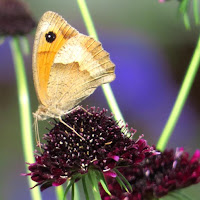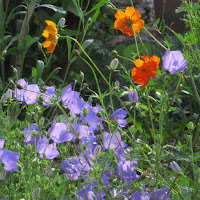"All the seeds of tomorrow
can be found in the flowers of today."
- Indian proverb
 |
| Sailboat entering the fishing port at Meschers sur Gironde |
Holiday-makers are thronging to our beachside resorts and little ports, welcomed by the full-on sun and temperate breezes.
At this time of year, we're more than happy to take refuge in our shady back garden, keeping an eye on any plants which show signs of wilting, and only venturing out for walks in the late evening or early morning.
At this time of year, we're more than happy to take refuge in our shady back garden, keeping an eye on any plants which show signs of wilting, and only venturing out for walks in the late evening or early morning.
 |
| A path along the Gironde at Barzan Plage |
One shrub which brightens up coastal areas is the deceptively feathery-looking Tamarisk - also spelt Tamarix - which is often grown in saline soils and provides a useful windbreak.
It may look wispy but is actually very robust and stands up to buffeting salt-laden winds before rewarding us with a profusion of pink blooms.
 |
| Tamarisk pentandra blooming in July |
As far as I can make out, the form known as Tamarisk tetandra blooms in springtime, whilst the slightly darker flowers of Tamarisk pentandra are widely in evidence now.
Pretty though it is, I'd find it a trifle too messy and undisciplined for most gardens - unless, of course, you're lucky enough to be right on the shore!
 |
| Evening sun picking out individual flowers |
Having said that, our back garden is starting to look distinctly wild and exuberant in mid-July, stuffed as it is with an array of flowering plants jostling for space, each species seeking its moment in the spotlight.
Summer Colour
Close to the table where we eat supper, are the nodding heads of Campanula carpatica which thrives in semi-shade and comes alive when the low evening light shines through its delicate harebells.
As with so many of our blue/mauve flowers, we intersperse them with contrasting orange blooms - in this case the annual Cosmos sulphureus 'Polidor mix' from Chiltern Seeds.
Scabious is a plant which grows well on our chalky soil and we managed to get hold of this many-branched variety called 'Black Knight' which is covered with dark pincushion flowers and stands out well in the border.
With its tall, strong stems this makes a good variety for cutting and my only criticism might be that the flowers turn to seed a bit too quickly. At this point in summer, we can spend an awful lot of time dead-heading in order to keep plants looking their best!
Salvias are an excellent species for injecting some drama into a sunny border... None more so than 'Amistad' which boasts deep purple flowers sprouting from an almost black calyx.
It's a hybrid which was developed in Argentina and is slightly tender in our climate. This one is similar in style to one of our favourites, Salvia guaranitica 'Black and Blue', now standing about 2m high at the back of the herb bed.
'Amistad' is not quite as tall or bushy as yet but its flowers are larger and the shrub may well fill out this season as we continue to dead-head spent blooms.
Evening primrose is one of those plants which continues to delight the eye throughout summer.
We grew this variety from seed a few years ago and it happily reproduces itself throughout the garden - a bit like Gaura lindheimeri, a relative with similar-looking seedlings. We pull up most of the babies to stop it getting out of hand, but there's always an odd one popping up between other perennials, surprising us with a fresh, slightly scented flower each day.
For lots of vibrant, trouble-free colour you can't beat some of the modern cranesbill geraniums, especially those like 'Patricia' which have been given the RHS Award for Garden Merit.
This one has been scrambling under the medlar tree and producing a steady stream of large flowers (5cm across) since the middle of June.
Like many types of geranium, we've found that both Verbena rigida and Dianthus superbus do well in full sun or partial shade.
This combination wasn't exactly planned but is perhaps more effective in a shady area where the subtle shape of the pale mauve dianthus and the intense violet of the verbena really come into their own.
Both make reliable and lovely perennials, cultivated from seed supplied by Chiltern Seeds.
To introduce something spikily different into our raised bed with its free-draining soil, we planted this eryngium which has an attractive mix of marbled leaves and silvery bracts.
I'm not sure what variety this is, having bought it sparsely labelled from a nursery after we had trouble trying to raise any from seed.
Yes, it's pretty but I still lust after the smaller Eryngium bourgatii with its steely blue stems. Perhaps it's time to try again?
 |
| Scabious atropurpurea 'Black Knight' being visited by a Meadow Brown |
With its tall, strong stems this makes a good variety for cutting and my only criticism might be that the flowers turn to seed a bit too quickly. At this point in summer, we can spend an awful lot of time dead-heading in order to keep plants looking their best!
 |
| Salvia 'Amistad' |
It's a hybrid which was developed in Argentina and is slightly tender in our climate. This one is similar in style to one of our favourites, Salvia guaranitica 'Black and Blue', now standing about 2m high at the back of the herb bed.
'Amistad' is not quite as tall or bushy as yet but its flowers are larger and the shrub may well fill out this season as we continue to dead-head spent blooms.
 |
| Oenothera 'Apricot Delight' - aptly named, it's a luminous yellow fading to apricot |
We grew this variety from seed a few years ago and it happily reproduces itself throughout the garden - a bit like Gaura lindheimeri, a relative with similar-looking seedlings. We pull up most of the babies to stop it getting out of hand, but there's always an odd one popping up between other perennials, surprising us with a fresh, slightly scented flower each day.
 |
| Geranium 'Patricia' - flowers for weeks |
This one has been scrambling under the medlar tree and producing a steady stream of large flowers (5cm across) since the middle of June.
 |
| Verbena rigida teamed with Dianthus superbus |
This combination wasn't exactly planned but is perhaps more effective in a shady area where the subtle shape of the pale mauve dianthus and the intense violet of the verbena really come into their own.
Both make reliable and lovely perennials, cultivated from seed supplied by Chiltern Seeds.
 |
| Eryngium planum |
I'm not sure what variety this is, having bought it sparsely labelled from a nursery after we had trouble trying to raise any from seed.
Yes, it's pretty but I still lust after the smaller Eryngium bourgatii with its steely blue stems. Perhaps it's time to try again?
 |
| Echinacea purpurea - one of those flowers which looks fabulous just at the moment of opening! |
Birds and beasts...
One morning we stepped out to the sound of excited quacking and discovered we were being paid a social call by a quartet of young ducks.
They took a tour round the garden - luckily the cat wasn't awake - and became hysterical when they couldn't find a way back to their nearby stream.
Eventually, three of them managed to squeeze through a gap in the fence, leaving the fourth and fattest member of the quartet to squawk indignantly until it finally found its escape through the open gate!
 |
| Une rainette or European tree frog |
It appears he's carefully guarding the single fruit which is maturing nicely but I'm afraid it doesn't look like a white peach - as Christina had hoped - but is probably a rather ordinary nectarine.
Ah well, you can't complain too much if you get fruit for free, even though we may end up fighting over who gets to eat it. (Let's hope it won't be Froggie... )
 |
| Roe deer at evening in a crop of sunflowers |


No comments:
Post a Comment